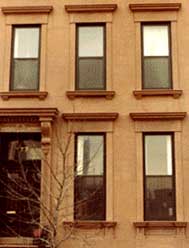
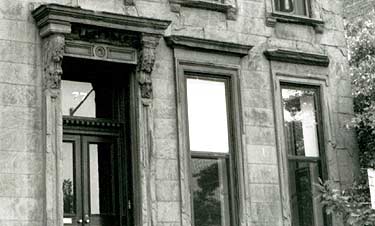


no.1
 If exterior materials can't be repaired,
If exterior materials can't be repaired,
DO find suitable replacement materials!
::issueFOCUS:: Choosing suitable replacement materials
::go to REHAB NO'S::
[TOP IMAGE] Brownstone rowhouse prior to rehabilitation. NPS photos.
The historic character...
This 1870 Italianate rowhouse was located in a historic district within
a heavily populated area. The owners planned to use most of the building
for rental housing and a portion of it for their own living quarters.
It is evident from this photograph that the facade, covered with a brownstone
veneer, was in a very serious state of deterioration.
Typical of a great many rowhouses of the mid-nineteenth century in this area, the building was faced with a rather poor quality sandstone. In addition, it is likely that the blocks of stone were incorrectly laid.
Instead of placing the stones on their natural bedding plane as they lay in the quarry—the correct method—the blocks of stone were "face-bedded." This caused the stones to scale in layers because they were placed on end with their bedding planes parallel to the face of the wall.
...and how it was preserved in the rehabilitation.
The owners selected a technique of stone repair that called for the delaminating
stone to be scaled back to a sound layer. This would provide a "key"
or "bond" for a coat of portland cement stucco.
The first coat of stucco applied to the stone substrate was tooled to
match, as much as possible, the original shape, design, and profile of
the stone trim and moldings. It was then covered over with a finish coat
of stucco, pigmented like brownstone, and finally, scored to resemble
the original blocks of stone. The resulting work matched the original
appearance, but was a slightly simplifed version, notably the foliated
door brackets and molded window architraves (see photos, right). All in
all, the resurfacing technique was satisfactory, and the rehabilitation
project met the Standards. Standard 6,
of particular importance in the project, is referenced on the right.
What should you know?
A frequent problem encountered in rehabilitation projects is how to repair
deteriorating stone. One of the types of stone most susceptible to decay,
and an element common to many historic buildings, is sandstone. Sandstone
is not a durable stone. It is inherently fragile, a characteristic further
accentuated by the fact that it was frequently laid incorrectly during
construction, exposing bedding planes to accelerated weathering, spalling,
or delamination.
|
At this time, there is still no conservation or preservation treatment that has been successful either in retarding decay or in "cosmetizing" deteriorating sandstone.
Matching replacement stone is usually not available because most of the original quarries have long since closed, and other sandstones seldom come close to providing a suitable match.
Generally, there are two somewhat limited options of traditional repair methods for spalling brownstone: (1) cover it with a cementitious stucco coating; or (2) find appropriate substitute or replacement materials. Both options, if carefully undertaken, are consistent with Standard 6. This Standard says that if replacement of historic materials is necessary, the new material should match the material being replaced in design, color, texture, and other visual qualities and, where possible, materials.
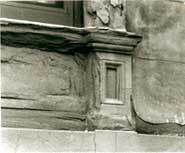
Window detail. Deteriorated brownstone before stucco repair.
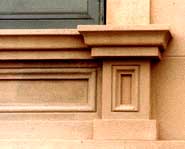
Same detail, after stucco repair. Simplified, but met the Standards.
Standard 6: Deteriorated historic features shall be repaired rather than replaced. Where the severity of deterioration requires replacement of a distinctive feature, the new feature shall match the old in design, color, texture, and other visual qualities and, where possible, materials. Replacement of missing historic features shall be substantiated by documentary, physical, or pictorial evidence.
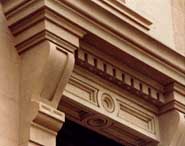
Detail, doorway brackets.
